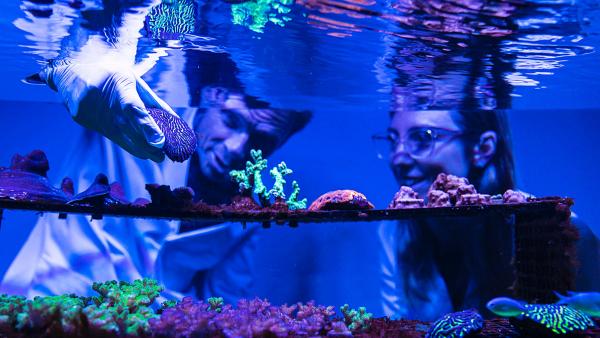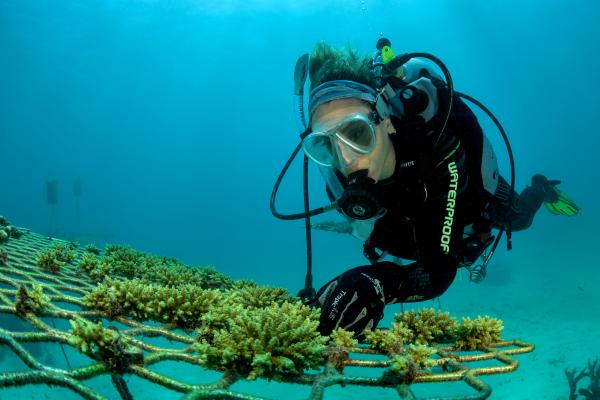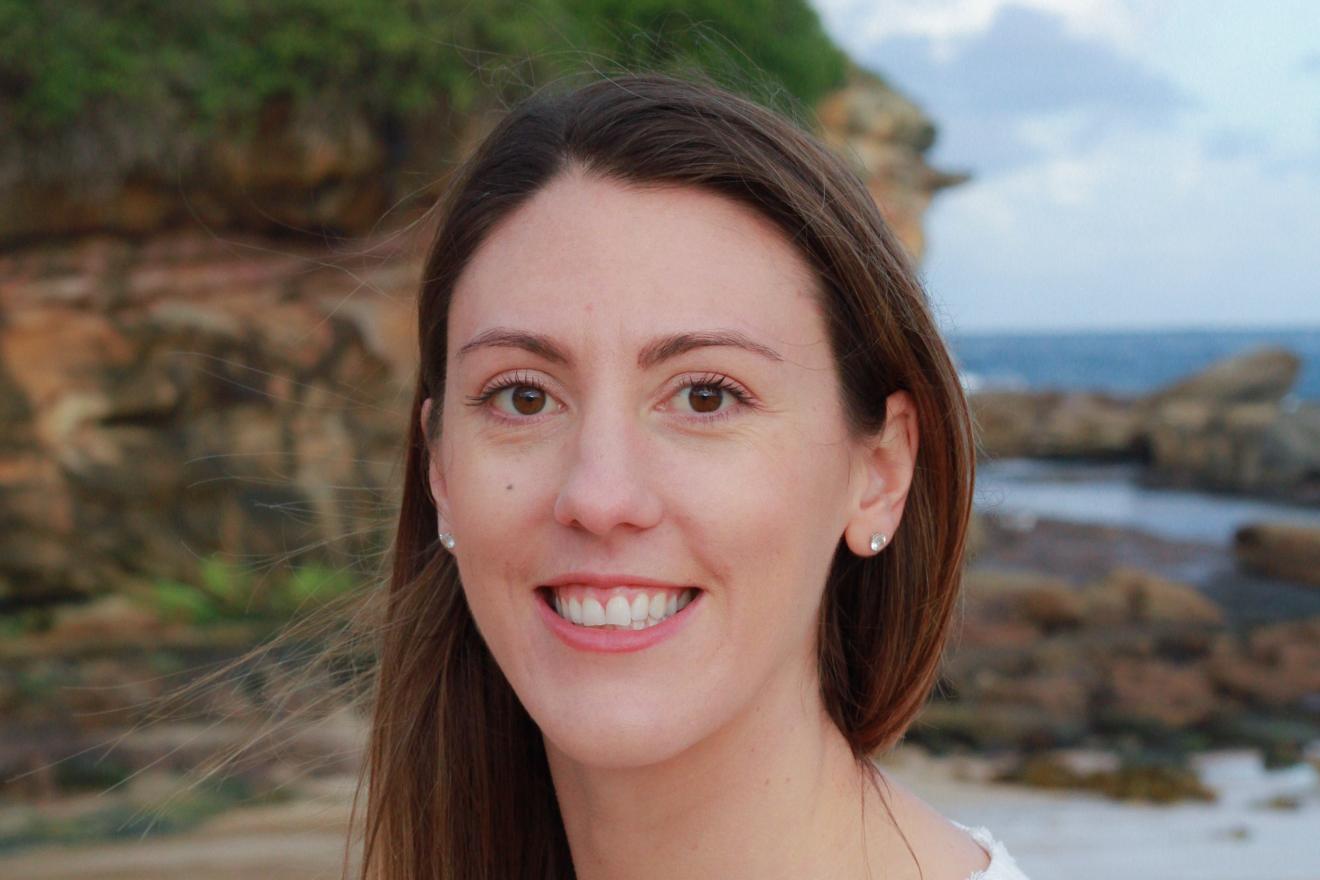Coral reefs are the most biodiverse marine ecosystems in the world but they face multiple threats to their survival from overfishing, water pollution and rising sea temperatures caused by climate change.
On the Great Barrier Reef, marine heatwaves in 2016 and 2017 caused mass bleaching of coral in the far northern sections—an event that was repeated in February this year when sea surface temperatures were the warmest ever recorded.
While the task of maintaining and restoring the health of the Reef is a huge shared responsibility, one initiative shows what can be achieved when stakeholders work together to benefit the reef and communities that rely on it.
In a world first, coral reef researchers at UTS are partnering with tourism operators in Queensland to develop an active coral restoration project that is already reaping benefits not just for the Great Barrier Reef but also for the communities that rely on the Reef for their livelihood.
Since its inception in 2018, the Coral Nurture Program led by Professor David Suggett and Dr Emma Camp, along with Wavelength Reef Cruises John Edmondson, has seen more than 25,000 corals outplanted to the Reef.
New funding support from the Great Barrier Reef Foundation, through its partnership with the Australian Government's Reef Trust, will enable tourism operators to plant an additional 100,000 corals on the reefs between Cairns and Port Douglas over the next 3.5 years, as well as transition Coral Nurture Program to a long-term reef stewardship platform.
Since its inception in 2018, the Coral Nuture Program has seen more than 25,000 corals outplanted to the reef
Dr Camp explains how the program came about.
“In some ways it was fortuitous. During a National Geographic research expedition we made to coral mangrove sites in 2017, in conversations we had with John Edmondson, who skippered the boat we were on, it became apparent that there was a gap between reef tour operators like him and scientists like us.”
The researchers were collecting data on what made certain coral more stress resistant and heat tolerant than others, relying on the tour operators’ extensive local knowledge and familiarity with unexplored reef sites. It’s common for tour operators like Edmondson to monitor and record the health of the reef, and to remove voracious coral predators such as the Crown of Thorns starfish, but he and others were keen to do more to actively preserve the precious source of their livelihood.
“The desire was there among operators to move from mitigation to restoration, to adopt established coral propagation practices tailored to reef rehabilitation. However, it wasn’t seen as cost-effective or something that could be done on a large scale based on existing approaches,” says Associate Professor Suggett, who is head of the Future Reefs Research Program at UTS.

David Suggett and Emma Camp in the coral lab
The Coral Nurture Program established the idea of site stewardship, empowering tour operators with tools and scientifically informed workflows they needed to help restore their local sites.
“Tour operators have amazing knowledge of their sites but they aren’t equipped to manipulate coral fragments and establish them in nurseries,” says Dr Camp.
One great enabler was Edmondson’s invention of a new way of attaching broken coral fragments onto the reef. He developed and patented a metal clip—called Coralclip®—that is simply hammered into the reef substrate, speeding up the rate at which coral can be planted out. It replaces the use of toxic epoxy glue widely used to do the same job but which is costly, requires teams of volunteers and is not always effective.
The Coralclip® technology is faster and cheaper than traditional methods and has contributed to a planted coral survival rate of 85 per cent. Add to this the effectiveness of nurseries to propagate corals to fast track growth to the size needed for reproduction, and the tools are there to accelerate the recovery of reproductively challenged parts of the reef.
“UTS secured a government grant to test the clip and to date we have outplanted 25,000 coral. But most of those you can’t tell that they have been planted as the clip simply rusts away,” says Edmondson.
The program is as much about social transformation as it is about ecological rehabilitation
New funding from the Great Barrier Reef Foundation is enabling a new phase for the Coral Nurture Program, where the project will rehabilitate “high value” tourism reef sites at greater scale whilst developing new sustainable financing.
There are now five tourism operators involved in Far North Queensland, including Ocean Freedom, Passions of Paradise, Sailaway, Quicksilver Group and Wavelength Reef Cruises. More are expected to join as the success of the Coral Nurture Program is more widely shared.
“We are on a pathway. We are not there yet. But as science progresses, we learn more. The heat tolerance [work] that Emma and David at UTS are doing, and understanding how diverse corals react, what genetic markers might indicate that something is more able to survive, is vital in helping us select what to plant out,” says Edmondson. “We are the practitioners and they are the scientific guidance.”
Dr Camp agrees that it has been a two-way learning experience. “As scientists we can have a view on what we think is best, but ultimately you need to be working with people who have livelihoods on the reef. There were very practical questions to be addressed, and it reinforced for me that we needed multi stakeholders on board if we were going to make an impact.”
Given that the Great Barrier Reef region supports 64,000 jobs and contributes more than $5 billion to the local economy, there’s a lot at stake—something that Professor Suggett advocates is central to the program, which is “as much about social transformation as it is about ecological rehabilitation”.
“This approach to reef rehabilitation becomes an integral part of a broader set of tools that allows the tourist industry to build resilience and sustainability,” he says. It also points the way for future research projects. “We are now working with other researchers and industries that are interested in restoring mangroves and forests. How successful we are is going to depend on how good we are at managing connected ecosystems.”
Research team
-
Professor, Climate Change Cluster
-
Chancellor's Postdoctoral Research Fellow, Climate Change Cluster
Faculty
- Faculty of Science
- Climate Change Cluster
Partners
- Wavelength Reef Cruises
- Ocean Freedom
- Passions of Paradise
- Sailaway
- Quicksilver Group
- Great Barrier Reef Foundation




